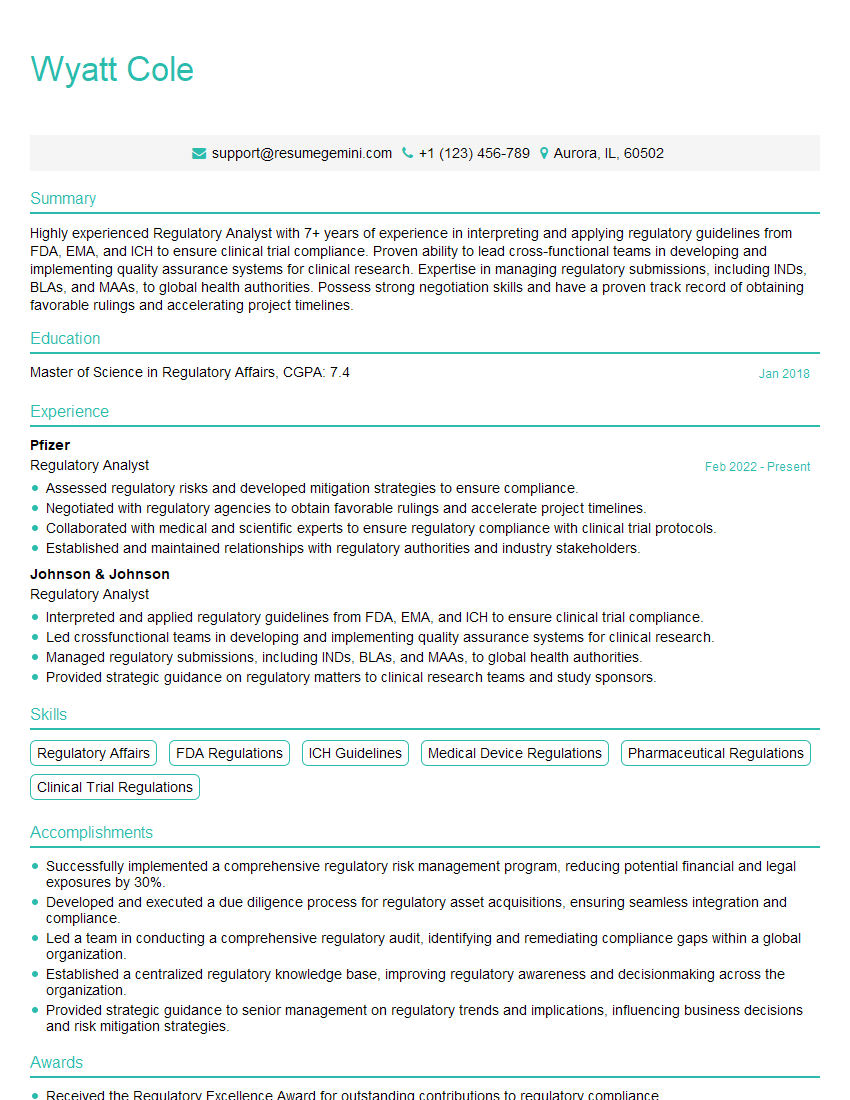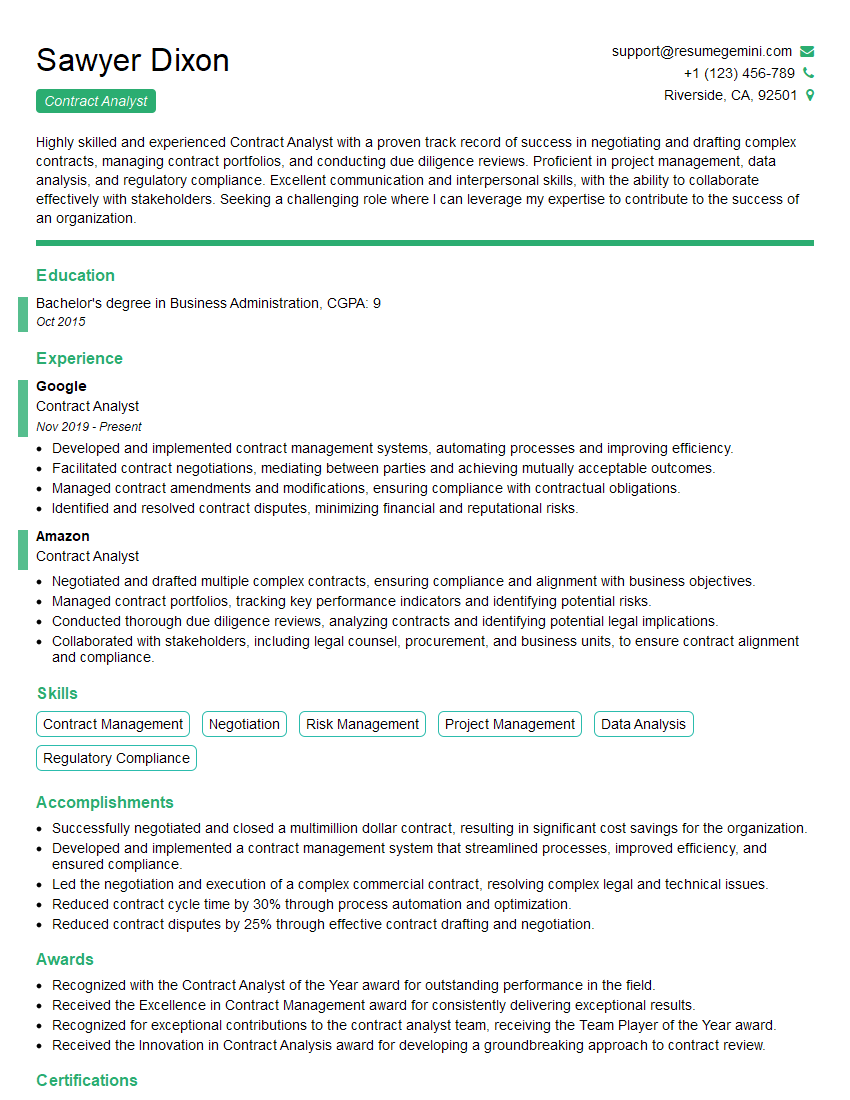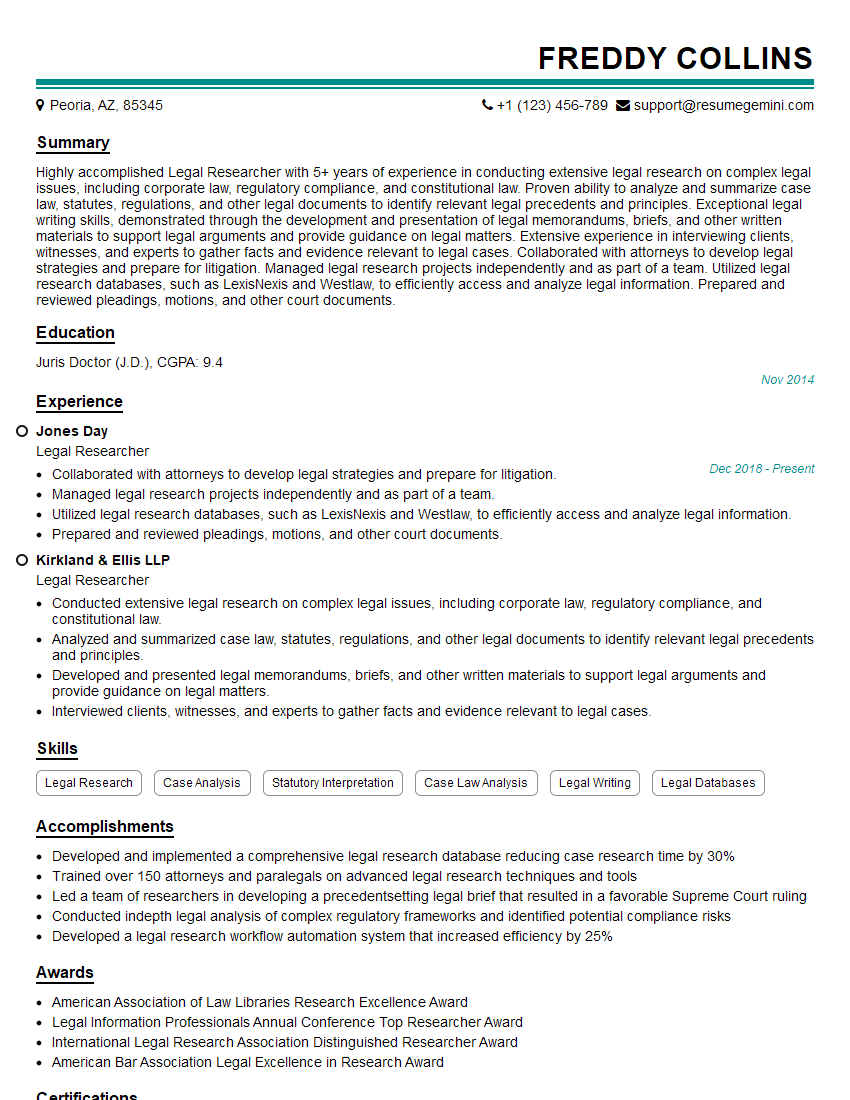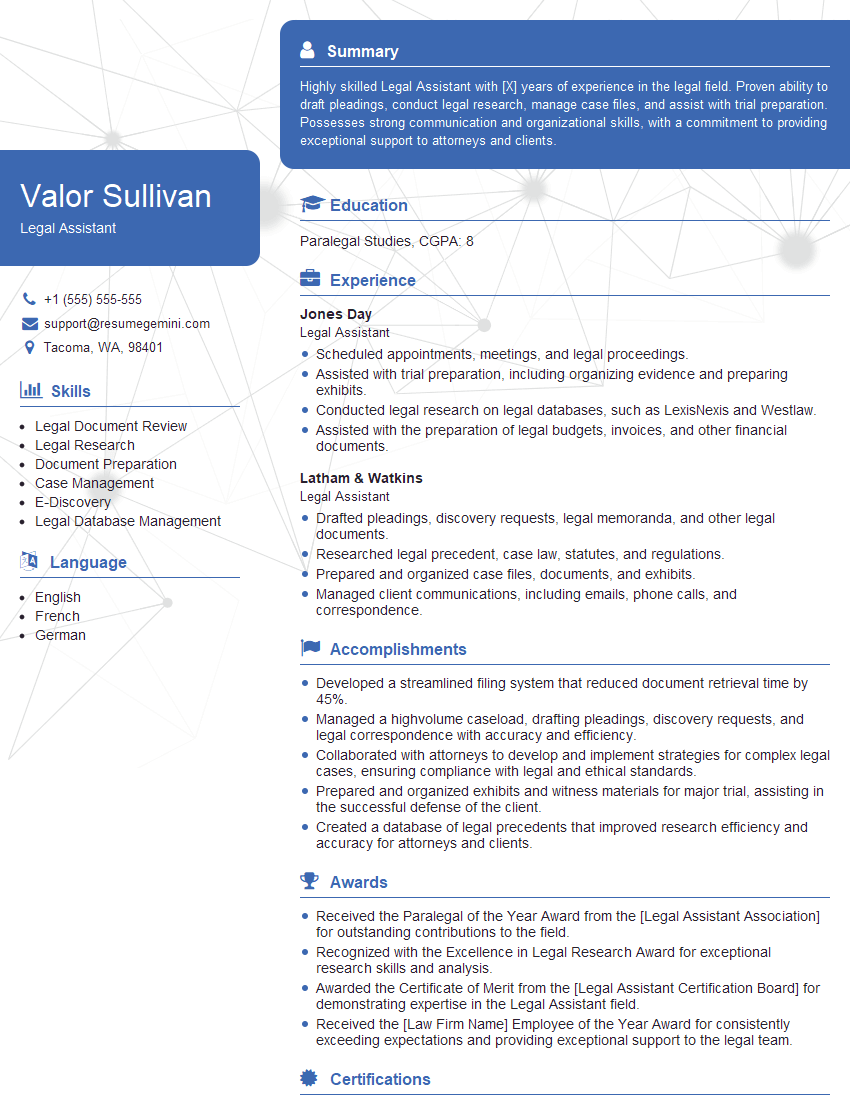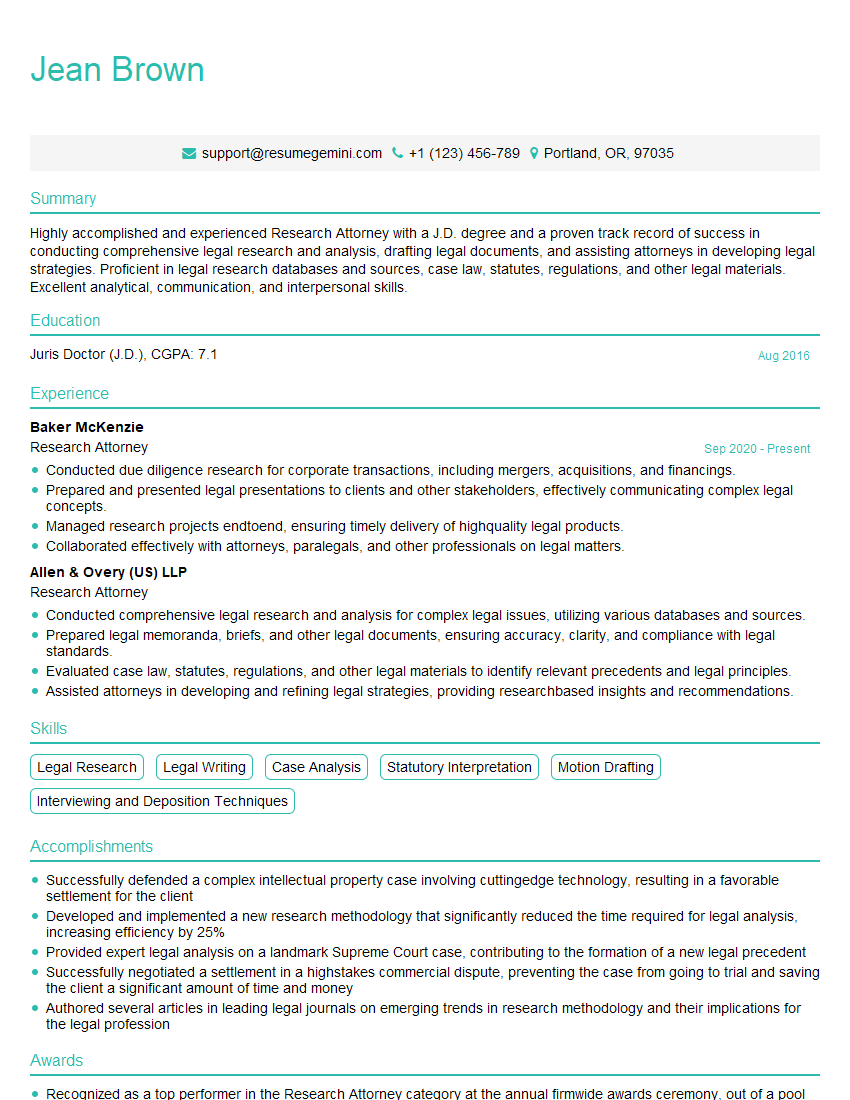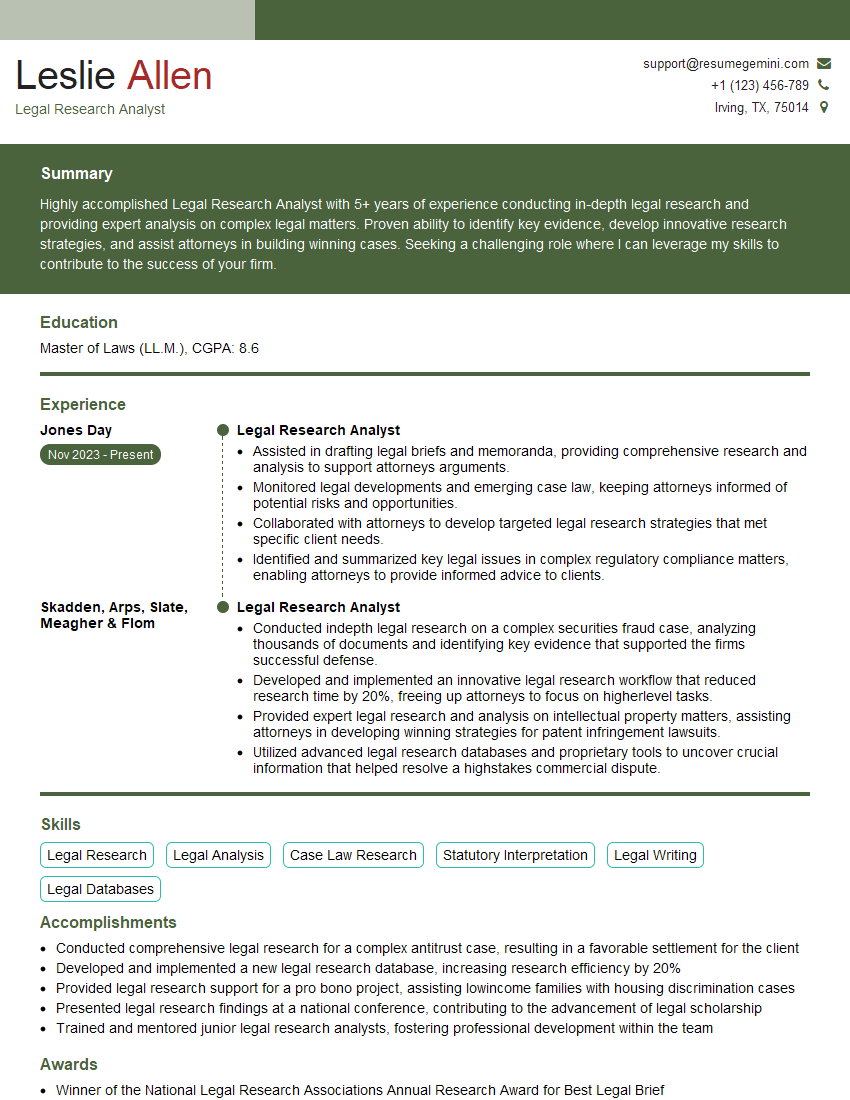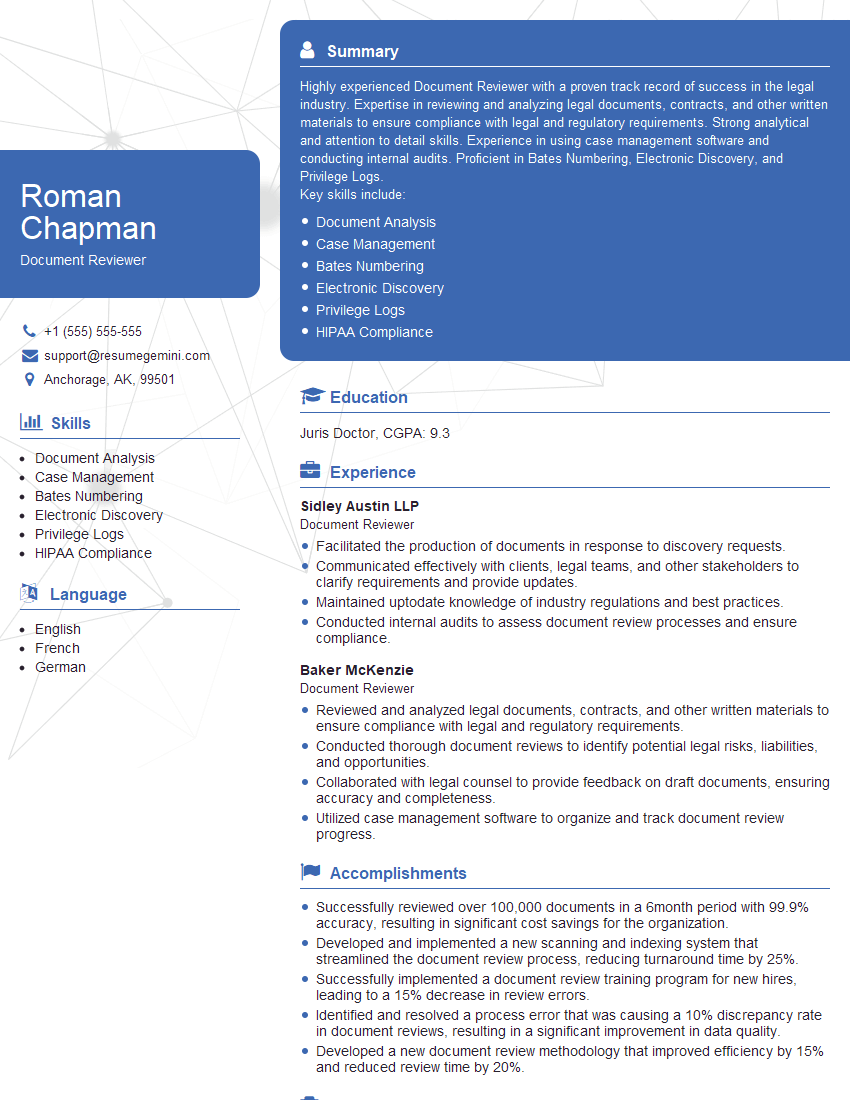Cracking a skill-specific interview, like one for Proficient in legal research and analysis, requires understanding the nuances of the role. In this blog, we present the questions you’re most likely to encounter, along with insights into how to answer them effectively. Let’s ensure you’re ready to make a strong impression.
Questions Asked in Proficient in legal research and analysis Interview
Q 1. Describe your experience with Westlaw or LexisNexis.
I possess extensive experience with both Westlaw and LexisNexis, utilizing them daily throughout my career. My proficiency encompasses not only basic searching techniques but also advanced functionalities such as Boolean searching, natural language searching, and the use of headnotes and key numbers to pinpoint relevant precedents. For instance, I recently used Westlaw’s KeyCite feature to verify the current status of a pivotal Supreme Court case, ensuring its continued validity and relevance to my client’s case. Similarly, I leveraged LexisNexis’ Shepard’s citation service to analyze the treatment of a specific statute by subsequent court decisions, allowing me to assess its interpretative history and predict potential outcomes.
My experience extends to utilizing both platforms’ advanced research tools to locate secondary sources, such as law review articles and treatises, which often provide crucial contextual analysis and differing perspectives on complex legal issues. I am comfortable navigating the complexities of both interfaces and extracting relevant information efficiently.
Q 2. How do you approach researching a complex legal issue?
My approach to researching a complex legal issue is methodical and multi-faceted. I begin by thoroughly understanding the client’s specific needs and the core legal questions at hand. This involves breaking down the issue into smaller, more manageable components. Next, I formulate a robust research strategy, identifying the relevant jurisdictions, statutes, regulations, and case law. I then employ a combination of keywords, Boolean operators (AND, OR, NOT), and natural language searches across Westlaw and LexisNexis, adapting my search strategy as needed based on initial results.
For example, if researching the legality of a particular advertising practice, I would start by identifying the relevant statutes (e.g., federal and state consumer protection laws), then search for relevant case law using keywords like “false advertising,” “deceptive trade practices,” and the specific industry involved. I wouldn’t stop there; I would also consult secondary sources like law review articles and legal treatises specializing in advertising law to gain a broader understanding of the legal landscape and emerging trends.
Finally, I meticulously document my research process, recording each search term, database used, and the relevant results, ensuring complete transparency and traceability.
Q 3. Explain your process for identifying relevant case law.
Identifying relevant case law involves a systematic process. It starts with crafting precise search terms that capture the essence of the legal issue. I often employ a combination of keywords, including specific legal terms and descriptive phrases that reflect the facts of the case. Then, I utilize the advanced search capabilities of Westlaw and LexisNexis, employing Boolean operators to refine my search results. This approach allows me to identify cases that share similar facts, legal issues, and holdings.
For instance, if researching the duty of care owed by a property owner, I would use keywords such as “premises liability,” “negligence,” “duty of care,” and “slip and fall.” I would then refine my search by using Boolean operators, such as “premises liability AND negligence AND slip and fall,” to narrow the search to cases directly addressing the issue at hand. I would also utilize the Citators in both systems (KeyCite and Shepard’s) to find subsequent cases that have cited the initial cases I’ve found, ensuring that I am considering the most up-to-date case law.
I also leverage the subject matter indexing provided by both databases to locate cases categorized under relevant topical areas.
Q 4. What strategies do you use to ensure the accuracy and completeness of your research?
Accuracy and completeness are paramount. I employ several strategies to ensure both. First, I always consult multiple sources, cross-referencing information across different databases and secondary sources. This helps to validate findings and identify any inconsistencies or potential biases. Second, I meticulously review the full text of cases and statutes, not relying solely on headnotes or summaries. Third, I maintain detailed research logs, meticulously documenting my search terms, sources consulted, and findings, allowing for easy verification and replication of the process.
Furthermore, I frequently use citators to check the validity and current status of cases, ensuring that they haven’t been overruled, reversed, or otherwise affected by subsequent decisions. This helps to avoid relying on outdated or superseded legal authority. Finally, I maintain a thorough understanding of the jurisdiction and the relevant rules of evidence, ensuring that only applicable and admissible evidence is considered.
Q 5. How do you handle conflicting legal precedents?
Conflicting precedents present a common challenge. My approach is to analyze the conflicting cases meticulously, considering factors like the jurisdictions involved, the dates of the decisions, the facts of each case, and the reasoning employed by the courts. I look for distinguishing factors between the cases that might explain the differences in outcomes. For example, a seemingly conflicting case might involve a different state’s law or significantly different facts.
I also research whether any higher courts have addressed the conflict directly. If a higher court has ruled on the issue, that decision will typically supersede the conflicting lower court decisions. If the conflict remains unresolved, I will clearly present both sides of the argument, acknowledging the discrepancy and highlighting the factors that might influence a court’s decision in a new case. I might also analyze the trends in case law to predict potential future rulings.
Q 6. How familiar are you with different legal citation styles (e.g., Bluebook, ALWD)?
I am proficient in several legal citation styles, including the Bluebook and ALWD. I understand the nuances of each style and can seamlessly adapt my citation practices to meet the specific requirements of different courts, law firms, or academic publications. I understand that consistent and accurate citation is critical for maintaining legal scholarship’s integrity and clarity.
My experience extends beyond simply formatting citations; I understand the underlying principles of legal citation, such as pinpointing specific sections of cases and statutes, using parallel citations, and ensuring that all cited materials are readily accessible. I am adept at utilizing citation management software to help streamline this process and ensure consistency.
Q 7. Describe your experience with legal research databases beyond Westlaw and LexisNexis.
My experience extends beyond Westlaw and LexisNexis. I am familiar with several other legal research databases, including Fastcase, HeinOnline, and various government websites offering access to legislative materials and court records. For instance, HeinOnline provides access to a vast collection of law reviews and other scholarly legal materials that are often invaluable in understanding the context and evolution of legal issues. Government websites are crucial for accessing primary sources such as statutes, regulations, and administrative decisions.
Using these diverse databases allows me to approach research comprehensively, broadening the scope and ensuring a more complete understanding of the legal issues. The choice of database depends on the specific research needs; for instance, while Westlaw and LexisNexis excel at case law research, HeinOnline is excellent for scholarly articles, and government websites are essential for accessing primary legislative materials.
Q 8. How do you stay updated on changes in legal precedent and legislation?
Staying current in the ever-evolving landscape of legal precedent and legislation requires a multi-pronged approach. It’s not just about reading statutes; it’s about understanding their interpretation and application.
- Subscription-Based Legal Databases: I rely heavily on Westlaw, LexisNexis, and Bloomberg Law. These databases provide automated updates on case law, statutes, and regulations, flagging changes relevant to my area of expertise. I set up alerts for specific keywords and jurisdictions.
- Legal News and Journals: I regularly read publications such as the New York Times, the Wall Street Journal, and specialized legal journals like the Harvard Law Review to stay abreast of significant legal developments and their broader societal impact. These provide context and analysis beyond the raw legal text.
- Continuing Legal Education (CLE): I actively participate in CLE courses and webinars to deepen my understanding of emerging legal issues and best practices. These courses often feature expert speakers who provide insights into recent case law and legislative changes.
- Professional Networks: Engaging with colleagues through professional organizations and online forums allows for the exchange of information and perspectives on recent case law and legislative trends. This collaborative learning is invaluable.
This combined strategy ensures I’m not just informed but also critically aware of the nuances and implications of legal changes.
Q 9. How do you evaluate the credibility and relevance of online legal sources?
Evaluating the credibility and relevance of online legal sources requires a discerning eye. Not all information found online is accurate or authoritative. Think of it like distinguishing between a credible news source and a gossip blog.
- Source Authority: I prioritize sources published by reputable legal publishers (like those mentioned above), government agencies, and established academic institutions. I check the author’s credentials to ensure expertise in the relevant area of law.
- Date of Publication: Legal information can quickly become outdated. I pay close attention to publication dates, ensuring the source is current. Outdated information can be misleading and even detrimental to a case.
- Cross-Referencing: I rarely rely on a single source. I verify information by cross-referencing it with multiple authoritative sources. This helps to identify inconsistencies or biases.
- Website Reputation: I look for websites with clear contact information, a well-defined editorial policy, and a strong track record of providing accurate information. A quick Google search for reviews can also be helpful.
By following these steps, I can effectively filter out unreliable information and focus on trustworthy, relevant sources for my research.
Q 10. Describe a time you had to research a novel legal issue. How did you approach it?
In a recent case involving the application of a novel state law regarding data privacy to social media platforms, I had to navigate largely uncharted legal territory. There was little direct precedent. My approach was systematic and iterative.
- Initial Keyword Research: I began with broad keyword searches in legal databases using terms like “data privacy,” “social media,” “[State Name] law,” and related concepts. This helped me identify any existing, albeit potentially tangential, case law or scholarly articles.
- Analogous Case Law: Since direct precedent was lacking, I looked for similar cases in other jurisdictions addressing related issues, such as those involving other forms of online data collection or different privacy statutes. I analyzed these cases to identify applicable legal principles and reasoning.
- Legislative History: I meticulously reviewed the legislative history of the new state law, including committee reports, floor debates, and any other materials explaining the legislators’ intent. Understanding the rationale behind the law was critical for interpreting its application.
- Scholarly Articles: I consulted law review articles and academic commentary on data privacy and social media to identify scholarly arguments and interpretations of the relevant legal principles.
- Iterative Refinement: As I gathered information, I continuously refined my search terms and research strategy based on my findings, going back and forth between the various stages of research until I had a solid understanding of the issue.
This multi-faceted approach allowed me to build a comprehensive understanding of the novel legal issue, even without direct precedent, and construct a strong legal argument based on sound reasoning and established legal principles.
Q 11. How do you organize and synthesize information from multiple legal sources?
Organizing and synthesizing information from multiple legal sources is a critical skill. I employ a combination of techniques to manage this process effectively.
- Detailed Note-Taking: I meticulously take notes on each source, summarizing key findings, relevant case citations, and any important arguments. This helps avoid information overload.
- Mind Mapping or Outlining: I use mind mapping or outlining software to visually organize the information and identify connections between different sources. This allows me to see the big picture and the relationships between different arguments and legal concepts.
- Thematic Organization: I group information thematically, focusing on key legal issues and sub-issues. This ensures a structured and coherent presentation of my research findings.
- Citation Management Software: I use citation management software (like Westlaw or Zotero) to organize and manage my sources, avoiding plagiarism and ensuring accurate attribution.
By using a combination of these approaches, I can efficiently synthesize information from multiple legal sources into a cohesive and persuasive argument.
Q 12. What are some common pitfalls to avoid during legal research?
Several common pitfalls can hinder effective legal research. Avoiding these is crucial for delivering accurate and reliable legal advice.
- Insufficient Research: Jumping to conclusions before thoroughly exploring all relevant sources is a common mistake. Comprehensive research is paramount.
- Over-reliance on a Single Source: Relying on only one source can lead to biased or incomplete information. Cross-referencing and diverse sources are essential.
- Ignoring Case History: Failing to trace the evolution of legal principles across relevant cases can lead to a misinterpretation of current law.
- Neglecting Statutory Interpretation: Misunderstanding the legislative intent behind statutes can lead to incorrect applications of the law.
- Poor Organization: Lack of organization can make research findings difficult to interpret and use effectively.
By being mindful of these potential problems and implementing a structured research approach, I can minimize errors and ensure the highest quality of legal work.
Q 13. How proficient are you in using Boolean search operators?
I am highly proficient in using Boolean search operators (AND, OR, NOT) to refine my searches and improve the accuracy of my research results. These operators are fundamental to efficient legal research.
For example, searching for cases involving “contract breach AND negligence” will yield only results containing both terms, significantly narrowing the search results. Using “contract breach OR breach of warranty” broadens the search to include documents containing either term. The “NOT” operator allows for the exclusion of unwanted terms, for instance, “contract breach NOT insurance” would eliminate cases involving insurance.
I understand nested searches and the use of wildcards (* and ?) for more complex queries. My proficiency in Boolean operators enables me to effectively target specific legal issues and locate relevant materials quickly and efficiently in vast legal databases.
Q 14. How do you manage large volumes of legal documents efficiently?
Managing large volumes of legal documents efficiently involves a strategic approach combining technological tools and organizational skills.
- Document Management Systems: I utilize document management systems (DMS) to organize and store electronic documents, allowing for easy retrieval and keyword searching. This eliminates the chaos of countless physical files.
- Metadata Tagging: I meticulously tag documents with relevant keywords and metadata, making it easy to search and filter based on specific criteria. Consistent tagging is essential for efficient retrieval.
- Optical Character Recognition (OCR): When dealing with scanned documents, I use OCR software to convert them into searchable text, increasing the efficiency of keyword searches. This allows for easier analysis of large document sets.
- Summary and Annotation: I summarize key findings and annotate documents with relevant information. This greatly reduces the time needed for review later.
- Batch Processing Techniques: I utilize batch processing where possible to save time. For example, batch converting documents to PDF or applying metadata tags to multiple files at once.
By implementing these strategies, I can effectively manage large volumes of legal documents, ensuring that information is readily accessible and easily analyzed.
Q 15. Explain your understanding of statutory interpretation.
Statutory interpretation is the process by which courts interpret and apply legislation. It’s crucial because laws are often written in broad terms, leaving room for different interpretations depending on the specific context. Judges use various tools and techniques to determine the legislature’s intent.
Key Approaches:
- Literal Rule: Giving words their plain, ordinary meaning. This is the starting point, but if it leads to an absurd or unjust result, it’s abandoned.
- Golden Rule: Modifying the literal rule to avoid absurdity or inconsistency. It allows for a slight departure from the literal meaning when necessary.
- Mischief Rule (or Purposive Approach): Focuses on the problem the statute aims to solve. This involves considering the historical context, legislative debates, and the statute’s overall purpose.
Example: A law prohibiting ‘vehicles’ in a park might be interpreted differently depending on the approach. The literal rule might include bicycles, while the purposive approach might exclude them if the legislature’s intent was to prevent noise and air pollution from motorized vehicles.
In practice, judges often blend these approaches, considering legislative history, case law, and public policy to arrive at a reasoned interpretation.
Career Expert Tips:
- Ace those interviews! Prepare effectively by reviewing the Top 50 Most Common Interview Questions on ResumeGemini.
- Navigate your job search with confidence! Explore a wide range of Career Tips on ResumeGemini. Learn about common challenges and recommendations to overcome them.
- Craft the perfect resume! Master the Art of Resume Writing with ResumeGemini’s guide. Showcase your unique qualifications and achievements effectively.
- Don’t miss out on holiday savings! Build your dream resume with ResumeGemini’s ATS optimized templates.
Q 16. Describe your experience with legal document review.
My experience with legal document review is extensive. I’ve worked on numerous projects involving large volumes of documents, ranging from contracts and emails to regulatory filings and litigation materials. This includes identifying relevant documents, analyzing their content for key information, and summarizing findings in clear, concise reports.
I am proficient in using both manual and technology-assisted review (TAR) methods. For instance, I’ve used software like Relativity and Everlaw to perform keyword searches, concept clustering, and predictive coding to streamline the review process and improve efficiency. This allows for a more focused analysis, ensuring that critical information isn’t overlooked amidst large datasets.
A recent project involved reviewing thousands of emails for a major antitrust lawsuit. Using TAR, I quickly identified relevant communications between key executives, which significantly contributed to the case strategy.
Q 17. How do you handle ambiguity in legal language?
Ambiguity in legal language is a common challenge. To handle it effectively, I follow a structured approach:
- Contextual Analysis: I examine the surrounding text to understand the broader meaning and intent of the ambiguous phrase. What is the overall theme of the document?
- Definition and Interpretation: If the ambiguity persists, I consult dictionaries, legal encyclopedias, and case law for established definitions or interpretations of the specific terms.
- Legislative History: I review the legislative history of the statute or regulation to understand the lawmaker’s intent during its drafting and passage. This may include committee reports, floor debates, and other relevant documents.
- Canons of Construction: Established principles of statutory interpretation, such as ejusdem generis (of the same kind) and noscitur a sociis (known by its associates), provide guidance in resolving ambiguities.
Example: The phrase “reasonable accommodation” in employment discrimination law is often ambiguous. To interpret it, I’d consider the specific context (nature of the disability, workplace demands, etc.), relevant case law defining “reasonable,” and the overall goal of the law—to ensure equal employment opportunities.
Q 18. Explain your understanding of legal privilege and confidentiality.
Legal privilege and confidentiality are cornerstones of the legal system, protecting certain communications from disclosure. Legal privilege protects communications made in confidence between a client and their lawyer, doctor and patient, or other designated relationships. This protection ensures open and honest communication, allowing clients to seek legal advice without fear of their disclosures being used against them.
Confidentiality is a broader concept encompassing any information that should be kept secret, based on ethical obligations or contractual agreements. This includes client information, internal strategies, and sensitive business data.
Exceptions to Privilege: While strong, legal privilege is not absolute. Exceptions exist, for example, when a client reveals information about future crimes or when there is a dispute between a client and their lawyer.
Maintaining both privilege and confidentiality is paramount. I meticulously follow all applicable rules and regulations, including those relating to data security and client privacy.
Q 19. Describe your experience using specialized legal research tools (e.g., for intellectual property).
I have extensive experience using specialized legal research tools, particularly in intellectual property. I am proficient in using databases like Westlaw, LexisNexis, and specialized IP databases such as Patent Lens, Derwent Innovations Index, and Google Patents.
For example, in researching patent validity, I use Patent Lens to perform prior art searches, identifying existing technologies that might invalidate a patent claim. I also use Derwent Innovations Index to analyze patent families, understand the technological landscape, and assess the strength of a patent portfolio. Furthermore, I leverage Google Patents for its comprehensive search capabilities and easy access to patent documents worldwide.
My research skills also extend to trademark and copyright law, utilizing various databases and resources to check for existing registrations, assess likelihood of confusion, and analyze infringement claims.
Q 20. How do you determine the jurisdiction applicable to a legal issue?
Determining applicable jurisdiction is critical in any legal matter. It involves identifying the court or tribunal with the authority to hear a case. Several factors determine jurisdiction:
- Subject Matter Jurisdiction: Does the court have the authority to hear the type of case in question (e.g., contract disputes, criminal matters)?
- Personal Jurisdiction: Does the court have the authority over the parties involved? This often depends on residency, presence in the jurisdiction, or the nature of their activities within the jurisdiction.
- Venue: This relates to the specific location within a jurisdiction where a case should be heard, often determined by factors like where the events occurred or the defendant resides.
- Choice of Law: In many cases, contracts or statutes may specify the governing law, which influences the applicable jurisdiction.
Example: A contract dispute between a California company and a New York company might be litigated in either California or New York, depending on where the contract was formed, where it’s to be performed, and where the parties reside. This would involve careful analysis of the contract’s choice-of-law clause and relevant jurisdictional statutes.
Q 21. How do you present your legal research findings clearly and concisely?
Presenting legal research findings clearly and concisely involves structuring the information logically and using plain language. I typically follow this format:
- Executive Summary: A brief overview of the key findings and conclusions.
- Background: A concise explanation of the legal issue and the research objective.
- Analysis: A detailed discussion of the research methodology, sources, and key findings, presented in a logical sequence.
- Conclusion: A clear summary of the implications of the research, addressing the initial question or objective.
- Appendices (if needed): Supporting documents such as relevant statutes, cases, or excerpts from research databases.
Visual aids like charts, tables, and timelines can enhance clarity, especially when dealing with complex information. The style should be professional and easy to understand, even for non-legal professionals, avoiding unnecessary legal jargon where possible.
Q 22. Explain your understanding of different types of legal authorities (e.g., statutes, regulations, case law).
Legal authorities form the bedrock of legal arguments and decisions. They represent sources of law with varying levels of weight and influence. The primary types include:
- Statutes: These are laws passed by a legislature (e.g., Congress at the federal level, state legislatures at the state level). They are codified and published, providing clear and specific rules. For example, the Clean Air Act is a federal statute setting environmental standards.
- Regulations: These are rules and guidelines created by administrative agencies to implement and enforce statutes. They often delve into the specifics of how a statute is applied. The Environmental Protection Agency (EPA), for instance, creates regulations to define and enforce the Clean Air Act’s provisions.
- Case Law (Common Law): This encompasses judicial decisions that interpret statutes, regulations, and prior case law. Judges analyze facts and apply legal principles to create precedents. A landmark Supreme Court case like Brown v. Board of Education established a legal precedent affecting desegregation.
- Constitutions: Foundational documents that outline the fundamental principles and structure of a government, establishing the basis for other laws. The US Constitution, for example, is the supreme law of the land.
Understanding the hierarchy and interplay between these authorities is crucial for effective legal research and analysis. For example, a regulation conflicting with a statute would be invalid. Similarly, a court ruling interpreting a statute carries significant weight but can be overruled by a higher court or amended by the legislature.
Q 23. How do you use legal research to support the development of legal strategies?
Legal research is the backbone of developing effective legal strategies. It involves systematically identifying and analyzing relevant legal authorities to support a client’s position or a legal argument. My approach involves:
- Identifying Key Issues: Clearly define the legal questions at hand. For example, in a contract dispute, the key issues might be breach of contract and damages.
- Keyword Searching and Databases: I utilize Westlaw, LexisNexis, and other specialized legal databases to search for relevant statutes, regulations, cases, and scholarly articles using precise keywords and Boolean operators (AND, OR, NOT) to refine results.
- Shepardizing/KeyCite: I verify the current status of case law to ensure it hasn’t been overturned, reversed, or distinguished by later decisions. This is crucial for maintaining the validity of legal arguments.
- Analyzing Authorities: Critically evaluating the strength and relevance of each authority found. This includes understanding the reasoning and holding of court cases, the legislative intent behind statutes, and the scope of regulations.
- Synthesizing Information: Combining and summarizing the findings to build a comprehensive understanding of the legal landscape, supporting the development of strategic arguments and recommendations for the client. This might include identifying potential weaknesses and defenses in a case.
Imagine a client facing a breach of contract claim. My research would uncover relevant contract law statutes, case law addressing similar breaches, and potentially relevant articles on contract interpretation. This information allows me to devise a strong defense strategy tailored to the specifics of the situation.
Q 24. How do you collaborate with other legal professionals on research projects?
Collaboration is key in legal research, especially on large or complex projects. I believe in open communication and a clear division of labor. My approach includes:
- Project Management Tools: Utilizing shared platforms (like project management software) to centralize research materials, track progress, and facilitate communication.
- Regular Meetings: Scheduling regular meetings to discuss progress, share findings, and identify areas requiring further investigation or clarification.
- Clear Communication: Maintaining open and consistent communication with team members about the project scope, deadlines, and individual roles and responsibilities.
- Shared Research Methodology: Establishing a consistent approach to legal research within the team (e.g., using specific databases and search strategies) to ensure consistency and efficiency.
- Feedback and Review: Encouraging feedback and peer review of research findings to ensure accuracy and identify potential flaws or biases.
For instance, during a multi-state litigation, we might divide research based on jurisdiction, with each member focusing on a specific state’s laws. Regular meetings ensure all information is synthesized for a unified legal strategy.
Q 25. Describe your experience with legal writing and briefing.
Legal writing and briefing are integral aspects of legal practice. My experience encompasses:
- Legal Memoranda: I can draft clear, concise, and persuasive legal memoranda, presenting the legal research and analysis in a structured format that facilitates decision-making by legal professionals. These clearly outline the facts, issue, rule, analysis, and conclusion (IRAC) method.
- Briefs: I’m proficient in writing appellate briefs, which require meticulously summarizing facts, legal arguments, and supporting case law for the benefit of the court. Attention to detail and adherence to strict formatting rules are paramount.
- Contracts and Other Legal Documents: I have experience in drafting and reviewing various legal documents, ensuring clarity, precision, and compliance with legal requirements.
- Client Communication: I can translate complex legal concepts into easily understandable language for clients, making the legal process more transparent and manageable.
For example, in preparing a legal memo for a judge, I would organize information based on the IRAC method (Issue, Rule, Application, Conclusion) to provide a clear and well-supported legal argument. The clarity and structure make it easy for the judge to quickly grasp the essence of the case.
Q 26. How do you ensure your legal research is objective and unbiased?
Objectivity and impartiality are fundamental to sound legal research. My approach includes:
- Multiple Sources: Consulting a variety of sources, including statutes, regulations, case law from different jurisdictions, and scholarly articles, to avoid relying on single perspectives.
- Awareness of Bias: Recognizing potential biases in sources, such as the author’s background or affiliations, and acknowledging their impact on the interpretation of information.
- Neutral Language: Using neutral and unbiased language in legal writing, avoiding emotional or subjective terms.
- Fact-Checking: Verifying the accuracy of information obtained from all sources.
- Peer Review: Seeking feedback from colleagues to identify and correct any potential biases in my research and analysis.
For example, while researching a case involving a controversial statute, I would seek out opposing viewpoints and critically evaluate the arguments on both sides to ensure a balanced understanding of the issue.
Q 27. How would you handle a situation where your research reveals unexpected information?
Uncovering unexpected information during research requires careful handling and transparent communication. My steps include:
- Verification: Thoroughly verify the accuracy of the unexpected information from multiple reputable sources. Is it from a credible source? Has it been peer-reviewed? Is it consistent with other information?
- Assessment of Significance: Assess the significance of the information in relation to the overall research project and legal strategy. How does this information affect the current legal strategy? Does it require a modification of strategy?
- Documentation: Meticulously document the unexpected information and the process of its verification. This is crucial for transparency and accountability.
- Communication: Communicate the findings and their potential implications to the relevant stakeholders (e.g., supervising attorney, client) promptly and transparently. This may involve discussing potential adjustments to the legal strategy.
- Strategic Adaptation: If necessary, adapt the legal strategy to account for the new information. This might involve additional research or re-evaluation of existing arguments.
Imagine discovering a previously unknown case with similar facts resulting in a different outcome. I would verify its validity, assess its impact on our case, document my findings, and advise my supervisor or client on potential strategic adjustments.
Q 28. What are your strategies for improving your legal research skills?
Continuously improving legal research skills is essential for staying ahead in this dynamic field. My strategies include:
- Continuing Education: Participating in workshops, seminars, and online courses to stay updated on legal research methodologies, technological advancements, and changes in the law.
- Advanced Search Techniques: Refining my understanding and application of Boolean operators and advanced search techniques to enhance the efficiency and effectiveness of my database searches.
- Mentorship: Seeking guidance and feedback from experienced legal professionals to refine my research skills and learn new strategies.
- Regular Practice: Actively engaging in diverse legal research projects to hone my skills and broaden my experience across various legal areas.
- Feedback and Self-Reflection: Regularly seeking feedback on my research work and critically reflecting on my performance to identify areas for improvement. I track my research time, efficiency, and accuracy to identify areas for enhancement.
This ongoing dedication ensures I remain at the forefront of legal research practices, capable of providing highly effective and accurate legal support.
Key Topics to Learn for Proficient in Legal Research and Analysis Interview
- Understanding Legal Databases: Mastering Westlaw, LexisNexis, and other relevant legal research platforms. This includes effective search strategies, Boolean operators, and understanding the structure of legal databases.
- Case Law Analysis: Developing skills in identifying key facts, legal issues, holdings, and reasoning in case law. Practicing application of precedent and distinguishing cases based on material facts.
- Statutory Interpretation: Understanding the process of interpreting statutes, including the plain meaning rule, legislative history, and canons of construction. Being able to apply statutory interpretation techniques to solve legal problems.
- Legal Writing and Communication: Crafting clear, concise, and persuasive legal memoranda, briefs, and other written documents. This includes proper legal citation and the ability to explain complex legal concepts in a straightforward manner.
- Research Methodology: Developing a systematic approach to legal research, including identifying the relevant legal issues, formulating research questions, and effectively using research tools to find authoritative sources.
- Practical Application: Applying your research skills to solve hypothetical legal problems and analyze real-world scenarios. This could include analyzing fact patterns, identifying relevant law, and forming legal conclusions.
- Ethical Considerations in Legal Research: Understanding the ethical responsibilities associated with legal research, including proper citation, avoiding plagiarism, and maintaining confidentiality.
Next Steps
Proficiency in legal research and analysis is paramount for career advancement in the legal field, opening doors to diverse and challenging opportunities. A strong foundation in these skills will significantly enhance your competitiveness and allow you to tackle complex legal issues with confidence. To maximize your job prospects, crafting a compelling and ATS-friendly resume is essential. ResumeGemini is a trusted resource that can help you build a professional resume that showcases your skills and experience effectively. Examples of resumes tailored specifically to highlight proficiency in legal research and analysis are available to guide you. Invest time in refining your resume – it’s your first impression!
Explore more articles
Users Rating of Our Blogs
Share Your Experience
We value your feedback! Please rate our content and share your thoughts (optional).
What Readers Say About Our Blog
Hello,
We found issues with your domain’s email setup that may be sending your messages to spam or blocking them completely. InboxShield Mini shows you how to fix it in minutes — no tech skills required.
Scan your domain now for details: https://inboxshield-mini.com/
— Adam @ InboxShield Mini
Reply STOP to unsubscribe
Hi, are you owner of interviewgemini.com? What if I told you I could help you find extra time in your schedule, reconnect with leads you didn’t even realize you missed, and bring in more “I want to work with you” conversations, without increasing your ad spend or hiring a full-time employee?
All with a flexible, budget-friendly service that could easily pay for itself. Sounds good?
Would it be nice to jump on a quick 10-minute call so I can show you exactly how we make this work?
Best,
Hapei
Marketing Director
Hey, I know you’re the owner of interviewgemini.com. I’ll be quick.
Fundraising for your business is tough and time-consuming. We make it easier by guaranteeing two private investor meetings each month, for six months. No demos, no pitch events – just direct introductions to active investors matched to your startup.
If youR17;re raising, this could help you build real momentum. Want me to send more info?
Hi, I represent an SEO company that specialises in getting you AI citations and higher rankings on Google. I’d like to offer you a 100% free SEO audit for your website. Would you be interested?
Hi, I represent an SEO company that specialises in getting you AI citations and higher rankings on Google. I’d like to offer you a 100% free SEO audit for your website. Would you be interested?
good
